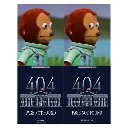-
 Bitcoin
Bitcoin $82,888.2507
0.21% -
 Ethereum
Ethereum $1,826.4116
0.80% -
 Tether USDt
Tether USDt $0.9998
0.01% -
 XRP
XRP $2.0924
-2.17% -
 BNB
BNB $600.4086
-0.52% -
 Solana
Solana $126.0638
1.46% -
 USDC
USDC $0.9999
-0.01% -
 Dogecoin
Dogecoin $0.1640
-2.63% -
 Cardano
Cardano $0.6498
-2.77% -
 TRON
TRON $0.2356
2.43% -
 Toncoin
Toncoin $3.9911
5.30% -
 Chainlink
Chainlink $13.4207
-0.87% -
 UNUS SED LEO
UNUS SED LEO $9.0861
-6.24% -
 Stellar
Stellar $0.2672
0.13% -
 Avalanche
Avalanche $18.7915
-2.46% -
 Shiba Inu
Shiba Inu $0.0...01227
-2.25% -
 Sui
Sui $2.2578
-3.57% -
 Hedera
Hedera $0.1630
-3.90% -
 Polkadot
Polkadot $4.0311
-0.30% -
 MANTRA
MANTRA $6.3127
1.62% -
 Litecoin
Litecoin $82.2584
-3.82% -
 Bitcoin Cash
Bitcoin Cash $300.3792
-1.34% -
 Bitget Token
Bitget Token $4.4887
-1.64% -
 Dai
Dai $0.9999
0.00% -
 Ethena USDe
Ethena USDe $0.9999
0.02% -
 Pi
Pi $0.7023
-7.73% -
 Hyperliquid
Hyperliquid $12.7602
2.76% -
 Monero
Monero $216.6686
0.09% -
 Uniswap
Uniswap $5.9473
0.32% -
 Aptos
Aptos $5.3341
1.57%
Is the liquidity of digital collections better than that of traditional artworks?
Digital and traditional art liquidity depends on numerous factors; while digital art benefits from faster online transactions, traditional art's established market structures and perceived value offer counterpoints. Rarity, provenance, and artist reputation influence both.
Mar 16, 2025 at 05:30 am
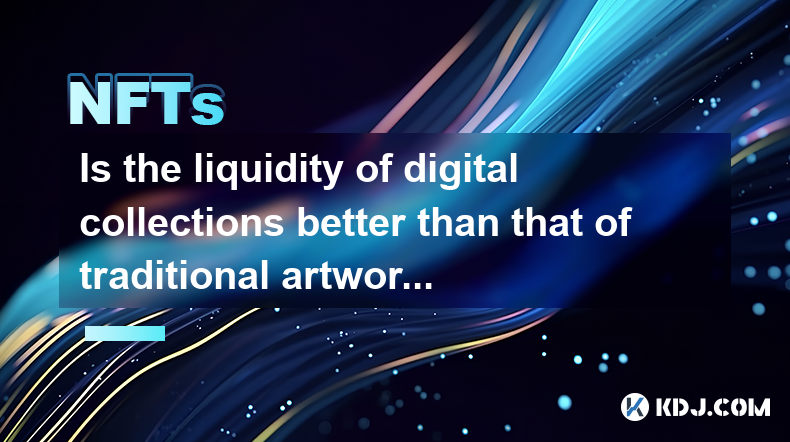
Key Points:
- Liquidity in both digital and traditional art markets varies significantly depending on the specific artwork and market conditions.
- Digital collections benefit from the ease and speed of online transactions, potentially increasing liquidity for certain pieces.
- The decentralized nature of some digital marketplaces can also affect liquidity, potentially both positively and negatively.
- Factors like provenance, rarity, and artist reputation influence liquidity in both markets.
- Traditional art often relies on established auction houses and galleries, which can limit accessibility and speed of transactions.
Is the liquidity of digital collections better than that of traditional artworks?
The question of whether digital collections boast superior liquidity compared to traditional artworks is complex and doesn't lend itself to a simple yes or no answer. The liquidity of any asset, be it a digital painting or a Renaissance masterpiece, is determined by numerous intertwined factors. While digital collections offer some advantages in terms of accessibility and transaction speed, traditional artworks maintain strengths in established market structures and perceived value.
The accessibility of digital marketplaces is a significant factor contributing to potentially higher liquidity for certain digital collections. Platforms like OpenSea allow for 24/7 trading, removing the geographical and temporal limitations inherent in the traditional art world. This instant access can significantly speed up transactions, facilitating quicker sales and potentially improving liquidity.
However, the decentralized nature of many digital collection marketplaces introduces another layer of complexity. While this decentralization can, in theory, increase access and participation, it can also lead to volatility and unpredictability in pricing and trading volume. This contrasts with the more regulated and established markets for traditional art.
Traditional art markets, centered around established auction houses and galleries, often exhibit lower liquidity due to the slower and more involved process of buying and selling. The verification of authenticity, the logistical challenges of physical transportation, and the often-lengthy negotiation periods all contribute to this. This can make it harder to quickly liquidate a traditional artwork, even if it's highly valuable.
Rarity and provenance play a crucial role in determining the liquidity of both digital and traditional art. A highly sought-after digital artwork with a verifiable history and limited supply will likely enjoy greater liquidity than a less-desirable piece. Similarly, a rare painting with a documented history and renowned artist will command higher prices and be more readily traded than a less-known artwork.
The role of the artist's reputation also cannot be overlooked. A well-established artist in either the digital or traditional sphere will generally see their works command higher prices and experience greater liquidity. This is because established reputations often translate to higher demand and a more robust secondary market.
The cost and complexity of authentication significantly impact liquidity in both markets. For traditional art, authentication often involves expert appraisals and certifications, adding time and cost to the transaction. In the digital art world, blockchain technology offers potential solutions for verifying authenticity and ownership, but the technology is still evolving and its effectiveness is not universally accepted.
The inherent volatility of the cryptocurrency market also plays a crucial role. The value of many digital collections is directly tied to the value of cryptocurrencies like Ethereum. This means that fluctuations in cryptocurrency prices can significantly impact the perceived value and liquidity of digital collections, introducing an element of risk not present in the traditional art market to the same degree.
Another key difference lies in the ease of fractional ownership. While fractional ownership of traditional artworks is possible, it's considerably more complex to arrange. Digital collections, on the other hand, can be easily fractionalised using NFTs, allowing for increased participation and potentially improved liquidity through broader ownership.
Frequently Asked Questions:
Q: Are digital art NFTs always liquid?
A: No, the liquidity of NFTs varies greatly depending on factors like artist popularity, rarity, and overall market conditions. Many NFTs have very low trading volume and may be difficult to sell quickly.
Q: How does the blockchain affect the liquidity of digital collections?
A: Blockchain technology offers transparency and verifiability of ownership, which can potentially increase trust and thus liquidity. However, the volatility of the cryptocurrency market, often intertwined with NFT pricing, can negatively affect liquidity.
Q: Can traditional artworks be as liquid as some digital collections?
A: Yes, highly sought-after traditional artworks by renowned artists can be quite liquid, often trading quickly at auction. However, the process is generally slower and less accessible than many digital marketplaces.
Q: What are the main factors affecting liquidity in both markets?
A: Rarity, provenance, artist reputation, market conditions, ease of transaction, and authentication methods all significantly impact liquidity in both traditional and digital art markets.
Q: Is it easier to sell a digital collection than a traditional artwork?
A: It can be easier to list a digital collection for sale, due to the readily available online marketplaces. However, achieving an actual sale quickly depends heavily on the specific artwork and market demand, and is not always guaranteed.
Disclaimer:info@kdj.com
The information provided is not trading advice. kdj.com does not assume any responsibility for any investments made based on the information provided in this article. Cryptocurrencies are highly volatile and it is highly recommended that you invest with caution after thorough research!
If you believe that the content used on this website infringes your copyright, please contact us immediately (info@kdj.com) and we will delete it promptly.
- X2Y2 NFT marketplace is shutting down after three years of operation
- 2025-03-31 22:40:13
- The Meme Index ($MEMEX) presale wraps up at 2 p.m. UTC, with over $4.5 million raised.
- 2025-03-31 22:40:13
- Coinbase Global (COIN) Stock Is About to Form the Dreaded Death Cross Pattern
- 2025-03-31 22:35:13
- The Evolution of Metis: A Pioneering Infrastructure Beyond a Single L2
- 2025-03-31 22:35:13
- As the Countdown to Launch Begins, This Meme Coin Project Intertwines One of the Most Compelling Adventurous Stories
- 2025-03-31 22:30:12
- Dawgz AI (DAGZ) Token, the Smartest Bet for 2025
- 2025-03-31 22:30:12
Related knowledge
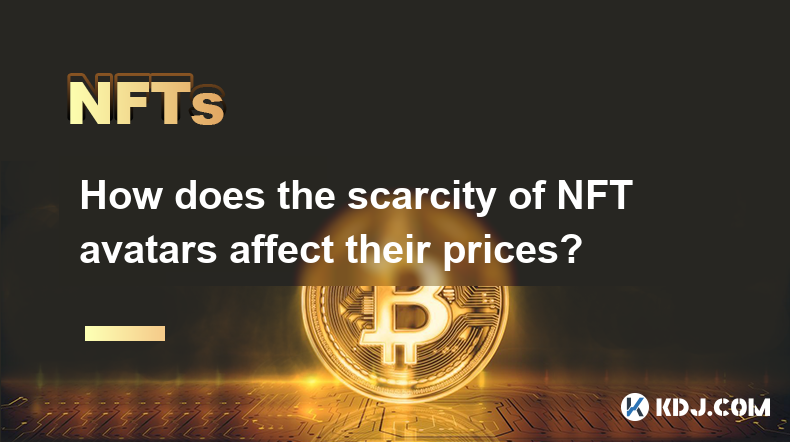
How does the scarcity of NFT avatars affect their prices?
Mar 25,2025 at 11:07pm
Key Points:Limited Supply: NFT avatar scarcity is directly tied to the fixed supply of a collection. A smaller number of unique avatars inherently increases their value due to higher demand.Demand Dynamics: High demand, fueled by factors like community hype, celebrity endorsements, and utility within a metaverse, significantly inflates prices.Rarity Att...

Can NFT avatars be copied or stolen?
Mar 21,2025 at 06:35am
Key Points:NFTs, by their nature, are unique and verifiable on the blockchain. However, the image associated with an NFT avatar can be copied.Copying an image doesn't grant ownership of the NFT itself. The original NFT and its ownership remain on the blockchain.Theft of an NFT involves gaining unauthorized access to a cryptocurrency wallet holding the N...

What is the creation process of NFT avatars?
Mar 19,2025 at 09:15pm
Key Points:NFT avatar creation begins with a concept and design.Various digital art tools and techniques are employed.Minting the avatar involves choosing a blockchain and marketplace.Metadata is crucial for defining the avatar's attributes.Promotion and marketing are vital for visibility and sales.What is the creation process of NFT avatars?The creatio...

Why do celebrities use NFT avatars as personal identification?
Mar 20,2025 at 07:15pm
Key Points:NFTs offer celebrities a unique and verifiable digital identity, distinct from easily imitated social media profiles.Using NFT avatars allows celebrities to control their online image and branding more effectively.NFT avatars can provide celebrities with new revenue streams through sales, licensing, and community building.The use of NFT avata...
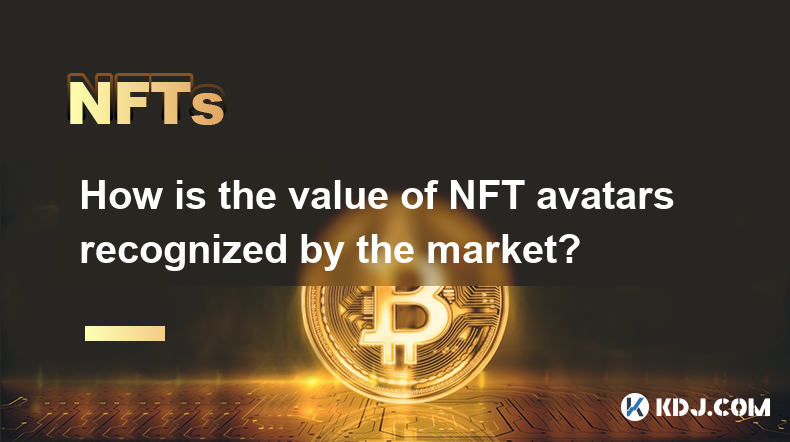
How is the value of NFT avatars recognized by the market?
Mar 21,2025 at 05:49am
Key Points:NFT avatar value is subjective and influenced by various factors, lacking a universally accepted valuation metric.Rarity, provenance, utility, community engagement, and the project's overall success significantly impact an avatar's value.Market demand, driven by trends, hype, and influencer adoption, plays a crucial role in price fluctuations...
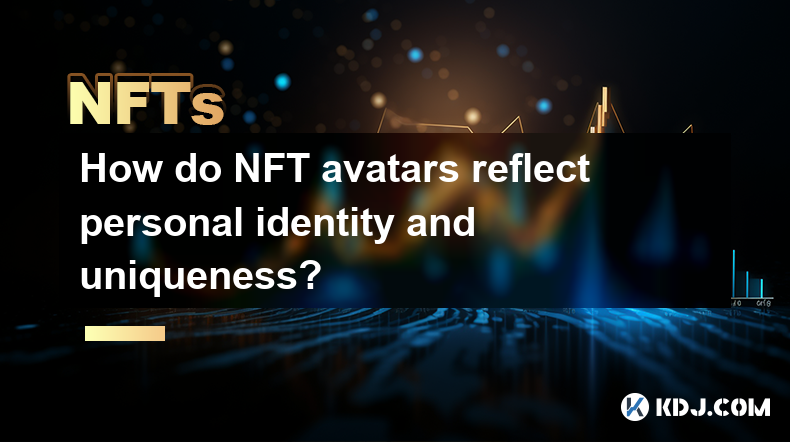
How do NFT avatars reflect personal identity and uniqueness?
Mar 21,2025 at 12:00pm
Key Points:NFT avatars are unique digital representations, verifiable on the blockchain, offering a distinct online identity.Ownership and scarcity drive the value and perceived uniqueness of NFT avatars, reflecting personal investment and commitment.Customization options, from initial design to in-game attributes, allow for expression of individuality....

How does the scarcity of NFT avatars affect their prices?
Mar 25,2025 at 11:07pm
Key Points:Limited Supply: NFT avatar scarcity is directly tied to the fixed supply of a collection. A smaller number of unique avatars inherently increases their value due to higher demand.Demand Dynamics: High demand, fueled by factors like community hype, celebrity endorsements, and utility within a metaverse, significantly inflates prices.Rarity Att...

Can NFT avatars be copied or stolen?
Mar 21,2025 at 06:35am
Key Points:NFTs, by their nature, are unique and verifiable on the blockchain. However, the image associated with an NFT avatar can be copied.Copying an image doesn't grant ownership of the NFT itself. The original NFT and its ownership remain on the blockchain.Theft of an NFT involves gaining unauthorized access to a cryptocurrency wallet holding the N...

What is the creation process of NFT avatars?
Mar 19,2025 at 09:15pm
Key Points:NFT avatar creation begins with a concept and design.Various digital art tools and techniques are employed.Minting the avatar involves choosing a blockchain and marketplace.Metadata is crucial for defining the avatar's attributes.Promotion and marketing are vital for visibility and sales.What is the creation process of NFT avatars?The creatio...

Why do celebrities use NFT avatars as personal identification?
Mar 20,2025 at 07:15pm
Key Points:NFTs offer celebrities a unique and verifiable digital identity, distinct from easily imitated social media profiles.Using NFT avatars allows celebrities to control their online image and branding more effectively.NFT avatars can provide celebrities with new revenue streams through sales, licensing, and community building.The use of NFT avata...

How is the value of NFT avatars recognized by the market?
Mar 21,2025 at 05:49am
Key Points:NFT avatar value is subjective and influenced by various factors, lacking a universally accepted valuation metric.Rarity, provenance, utility, community engagement, and the project's overall success significantly impact an avatar's value.Market demand, driven by trends, hype, and influencer adoption, plays a crucial role in price fluctuations...

How do NFT avatars reflect personal identity and uniqueness?
Mar 21,2025 at 12:00pm
Key Points:NFT avatars are unique digital representations, verifiable on the blockchain, offering a distinct online identity.Ownership and scarcity drive the value and perceived uniqueness of NFT avatars, reflecting personal investment and commitment.Customization options, from initial design to in-game attributes, allow for expression of individuality....
See all articles




















































































